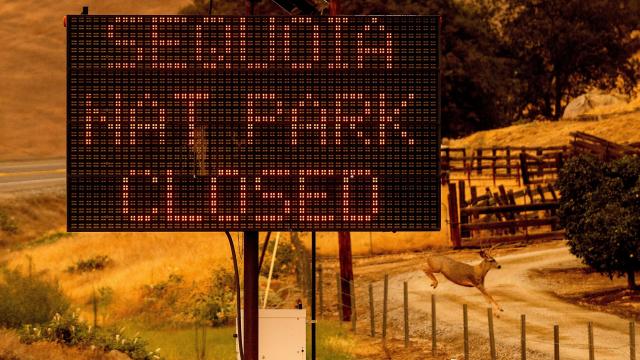Two fires sparked last week by lightning strikes in Sequoia National Park have caused the park to close to visitors and are threatening the endangered trees as the fires continue to spread, the National Park Service said Tuesday. They add to California’s increasingly dire season of flames.
The Paradise Fire and the Colony Fire, which are being referred to collectively as the KNP Complex Fire, had already burned through more than 2,000 hectares in Sequoia National Park Tuesday evening. The fire, which has no containment, more than quintupled over the course of 24 hours, charging through 1,940 hectares between Monday and Tuesday.
Officials expect the fires to keep the park closed for at least a week, if not longer. The road to the General Sherman tree, one of the park’s biggest attractions and the largest tree on Earth, measuring 31 metres around and 84 metres tall, was closed to visitors over the weekend.
Employees within the park were evacuated Monday night as the Paradise Fire raged downhill and crossed a river, burning towards park headquarters. Three Rivers, a town in Tulare County that serves as the gateway to the park, was also under voluntary evacuation orders Monday, mirroring the situation that took place to the north in Lake Tahoe a few weeks ago as the Caldor Fire nearly burned into resort towns. The town’s 2,400 residents were also put under evacuation orders during the Castle Fire last year, and the economic toll of back-to-back visitor seasons marred by flames and smoke could be severe.
“We know business will bounce back, but it’s still crummy,” Josh Moore, the manager of a coffee shop, told the Visalia Times-Delta. “We got through last year’s fires when we were closed for about 10 days. If you don’t open for a week, you don’t get paid for a week.”
Park officials said Tuesday that the fire is also inching closer to clusters of sequoia groves that dot the park, and are burning near the Giant Forest, which is home to more than 8,000 sequoia trees. Drought-stricken trees and dead trees infested by beetles are providing fuel for the fire, which has also benefited from gusty winds and warm conditions. The steep terrain where the fire is raging is also proving challenging for ground crews to fight, so air crews “literally started painting the mountains red with retardant,” Clay Jordan, superintendent of Sequoia and Kings Canyon National Parks, told the Los Angeles Times.
“There’s no imminent threat to Giant Forest but that is a potential,” Mark Ruggiero, fire information officer for Sequoia and Kings Canyon National Parks, told the AP Tuesday.
The sequoias in the park have had a rough go over the past couple years, and are especially vulnerable to the state’s intensifying wildfires. Last year, the Castle Fire killed somewhere between 7,500 and 10,000 sequoia trees after it tore through the park in August; that number amounts to a whopping 10% to 14% of the world’s sequoia population. The Castle Fire was so intense that park employees spotted a sequoia that smoldered through the winter and into spring. Not all the trees killed in the fire were big old baddies like General Sherman — sequoias can live for thousands of years — but even the death of relatively younger trees is a crisis when the species are in such danger.
“Not much in my life in the natural world has made me cry, but this did,” Nate Stephenson, a research ecologist for the U.S. Geological Survey and sequoia researcher who works in the park, told the San Francisco Chronicle earlier this summer about the Castle Fire findings. “It hit me like a ton of bricks.”
It’s not just fires themselves that are threatening the sequoias: The intensity of the West’s drought also poses a big threat to the trees. The bone-dry conditions have made sequoias weaker and more vulnerable to infestations like beetles and foliage dieback, both of which lower the trees’ natural defences to wildfires. Sequoias have been able to live with fire for centuries because most groves see low-intensity burns that stay close to the ground.
But with their defences weakened and climate change driving more extreme fire behaviour, that equation is shifting. Bigger, more intense fires can also leap between the crowns of trees and do serious damage to the trees’ long-term prospects of survival.
“Sequoia trees are a fire-adaptive tree,” Ruggiero said. “It’s important to have fire to have sequoias thrive, but when we get such intense fires even the sequoias can’t stand up to them.”
